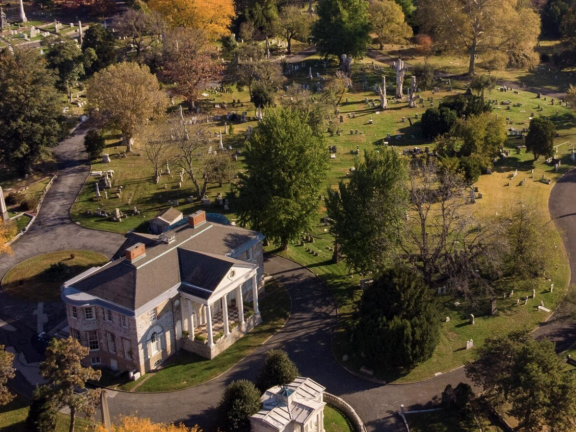The Woodlands

The Woodlands has a remarkable double importance: the country house of William Hamilton is one of the most artistically sophisticated examples of late eighteenth century architecture in America, and in the nineteenth century its beautiful gardens were transformed into one of the first “rural cemeteries,” the new kind of landscape that served as a model for our great public parks, including Fairmount Park.
William Hamilton (1745-1813) was a gentleman gardener, architect, botanist and collector of plants and art. Inheriting 356 acres on the west bank of the Schuylkill, he built a villa on a hill that afforded sweeping views south down the river. That first house, erected in ca. 1766-1774, was small, but it had a monumental four-column Roman portico on its south façade--one of the first evocations of an ancient temple in the New World. The porticoed villa formed the core of the much larger country house that Hamilton built in 1784-1789.
Hamilton launched his new project by consulting Thomas Nevell, the designer and builder of Mt. Pleasant (1760-1761), a large house further up the Schuylkill, and he employed the master builder John Child for the actual construction, but it appears that the design was largely his own. It was shaped by his extended stay in London in 1784-1786, during which, he reported, "My chief amusement is in viewing the best Houses in [and] about this metropolis."
Hamilton returned to Philadelphia with architectural ideas that were much more up-to-date than Mt. Pleasant. His design preserved the old portico, and behind it he built a house that was more than twice as big and contained an immensely varied ensemble of rooms: an elliptical drawing room, an oval dining room, an apse-ended salon in the center of the south façade, and a circular entrance hall to the north. The complexity of the spatial experience and the delicacy and thin proportions of the ornament were clearly inspired by the recent work of British neoclassicists—most notably Robert Adam.
While abroad, Hamilton also visited country house gardens and brought their lessons home, too. By the 1790s he had created a fashionable picturesque landscape park, which Thomas Jefferson called "the only rival I have known in America to what may be seen in England."
Hamilton died in 1813, and in 1828 his family began to sell off the Woodlands--the house, its gardens, and about 500 acres of farmland--to speculators and developers. Much land was developed for suburban houses, but huge parcels were acquired by the Blockley Almshouse (which became the Philadelphia General Hospital) and by the Woodlands Cemetery Company, which was created in 1840.
The Woodlands’ interesting topography, picturesque garden, and handsome house, combined with its proximity to the city, made it an excellent location for one of the new “rural cemeteries,” like the pathbreaking Mt. Auburn in Boston (1831) and Mt. Laurel, just up the Schuylkill (1836). These had been created to provide respectful, hygienic treatment of the dead in large industrial cities, and their picturesque, accessible gardens inspired the designers of public parks.
The Woodlands Cemetery project was steered by the lawyer and civic leader Eli K. Price (1797-1884), who transferred many of the strategies tested at Woodlands to Fairmount Park, where he was among the original and most forceful members of the Park Commission, founded in 1867. His collaborator at Woodlands was his brother Philip M. Price (1802-1870), a surveyor who had worked at Laurel Hill. Philip Price drafted the 1841-1842 plan that governed the first development. His design respected many aspects of Hamilton’s picturesque garden, and although some later sections are more formal, the irregular would prevail.
Sales of cemetery lots were slow at first, but business increased when several churches established strong partnerships with the cemetery. By 1852, the beautiful riverside landscape and historic mansion were attracting so many visitors that tickets became mandatory for Sunday admission.
The cemetery’s many tombs and monuments memorialize some of Philadelphia’s most notable citizens and showcase the great stylistic variety of nineteenth and early twentieth century architecture. Notable structures include the classical temple of the Drexels (1863), the domed Burns-Detre tomb (1882), the Furnessian Gothic chapel of the McDaniel family (1887), and Thomas Evans' grand obelisk (1901).
Address: 4000 Woodland Ave, Philadelphia, PA 19104
Check out a virtual map of the historic cemetery
Photo credit: The Woodlands